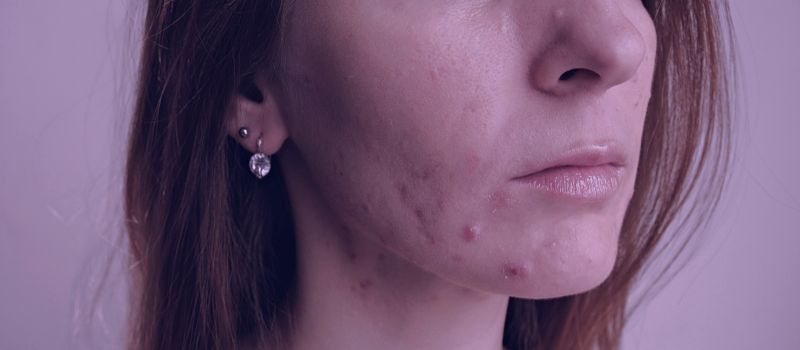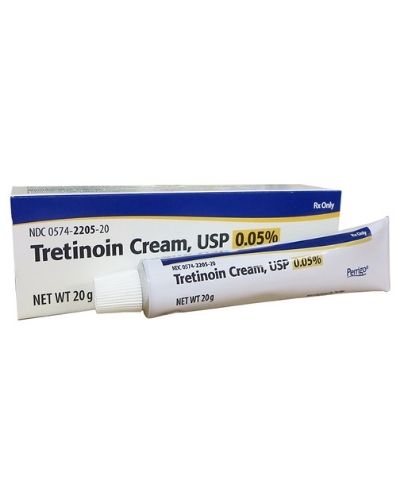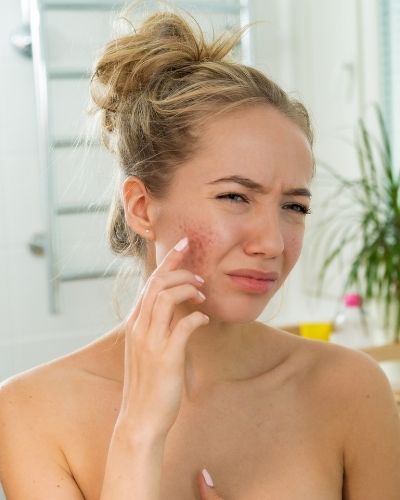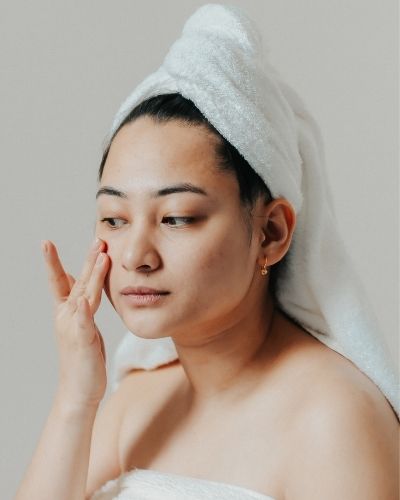If you’re like most people, you probably think of tretinoin as a medication that is only prescribed for its anti-aging benefits.
However, tretinoin is also an effective treatment for cystic acne and was originally only used as an acne treatment before people started noticing its anti-aging benefits.
In this article, I will talk about what cystic acne is, what causes it, how to prevent it in the first place, and how tretinoin works to clear this annoying but totally preventable condition.

What Causes Cystic Acne?
If you are like most people, you probably think that cystic acne is an exclusively hormonal condition that can’t seem to be addressed with a good skincare routine.
However, even though that’s partly true, cystic acne isn’t always caused by overactive or “bad” hormones.
In many cases, cystic acne starts as an inflammatory reaction to a clogged pore and becomes much bigger when not properly addressed.
There could be several different factors that cause clogs, leading to full-blown cystic acne.
Here are some of them:
Dehydrated Skin
Dehydrated skin is a skin condition that occurs when the skin lacks moisture.
Dehydrated skin often goes hand in hand with irritated skin that’s very reactive to external stimuli, such as products you’re using and even just plain water.
This usually occurs when the skin barrier is damaged and can’t retain moisture, which then drives the sebaceous glands into overproducing oil to make up for the lack of hydration.
Excess oil often concentrates inside the pore where it mixes with dead skin cells that didn’t shed properly, creating a clog and overgrowth of bacteria.
RELATED: Best Products For Dry And Flaky Skin
Oily Skin
Oily skin is another common factor in the formation of cystic acne.
Oily skin usually means that the oil-producing glands are overactive for reasons like genetics, overactive hormones, food intolerances, etc., and produce more oil than needed to lubricate the skin’s surface.
Some of this excess oil can’t push its way to the surface and tends to concentrate inside a pore, mixing with dead skin cells and causing a clog that allows for bacteria overgrowth.
Overactive Hormones
Overactive hormones, particularly the male group of hormones known as androgens, directly stimulate the oil-producing glands.
These hormones tend to become active during puberty, which is why this stage of life is a common time of experiencing acne for many people.
However, androgens can also become overactive due to reasons like consuming too much sugar, which is why sugar could potentially (and indirectly) be one of the causes of cystic acne.
It’s worth noting that not all cystic acne is hormonal, but for some people, overactive hormones could be the main cause of their acne.
The best way to determine this is to either get a food intolerance test or ask your health provider for a hormonal test.
If you suspect your acne might be hormonal, it’s a good idea to invest in these tests and figure out if this is really what’s causing you an issue.
RELATED: How Does Sugar Affect the Skin?
Clogging Cosmetic Products
Another common cause of cystic acne is using cosmetics and skincare products that are too heavy or occlusive for your skin.
When you use a product that’s too thick, it will often form a film on the skin’s surface, which will trap the sebum and oil inside the pore.
This can then cause a clog, overgrowth of bacteria, and inflammation which will eventually lead to cystic acne.
RELATED: Best Dermstore Products for Acne
Inflammatory Response to a Clogged Pore
As I already mentioned above, the main cause of cystic acne is most often due to our immune system.
A clogged pore allows for a buildup of sebum and dead skin cells, which then serve as food and a means for a specific strain of bacteria known as Cutibacterium acnes to proliferate.
Once your immune system detects the bacteria overgrowth, it recognizes it as something foreign and harmful and starts fighting against it by creating inflammation that manifests on the skin as larger, often pus-filled pimples.
However, when this also gets out of hand, the problem starts going deeper and deeper, resulting in large, painful cysts that don’t have a pus-filed head but instead appear as discolored lumps under the skin.
Food Intolerances
Finally, food intolerances can also be one of the main causes of cystic acne.
When we eat foods that our body recognizes as a “threat” and isn’t able to properly digest, it tends to cause inflammation in the gut, which then results in elevated levels of inflammation throughout the whole body.
Having a constant state of low-grade inflammation is a perfect ground for cystic acne because it means that your immune system is constantly on alert and reacts to even the tiniest stimuli, such as tiny clogs inside the pore.
If you suspect your skin might be inflamed due to something you eat, I highly recommend getting a food intolerance test done so that you can find out.
Dairy and sugar are often listed as some of the main causes of inflammation, and while this isn’t the case for everyone, we are all different, and our bodies try to protect us against things that we’re sensitive to by causing an even bigger problem.
RELATED: Does Spicy Food Cause Acne?
How Does Tretinoin Work to Treat Cystic Acne?

Tretinoin speeds up cell turnover (the rate that your skin produces new cells and sheds them from its surface.)
Slow skin cell turnover is also one of the main causes of cystic acne because it’s one fragment of what leads to clogged pores and an overgrowth of bacteria.
Therefore, after starting tretinoin, your skin cells will travel faster to the surface, purging clogs in the process and revealing a brighter, smoother, healthier, and more unified complexion.
RELATED: Beginners Guide to Tretinoin
How Long Should You Use Tretinoin to Treat Cystic Acne?
A tretinoin journey is definitely a slow one, and while this medication will help, it will likely take its sweet time to give results.
When using tretinoin to treat cystic acne, you will likely start seeing some improvement after 8-12 weeks of consistent use.
However, this isn’t set in stone, and depending on your skin, lifestyle, and other products that you are using in your skincare routine, it can take even longer or perhaps shorter than that.
With all that considered, most people’s skin tends to be significantly clearer, if not fully cleared, within a year of using tretinoin.
Side Effects of Using Tretinoin for Treating Cystic Acne?

Although very efficient in improving cystic acne, tretinoin definitely comes with its own set of troubles, which is why it’s advisable to take it easy and give your skin extra care when starting out.
Here are the most common side effects of using tretinoin:
Dryness & Irritation
Tretinoin works by speeding up the skin cell turnover cycle, ridding of the old layer of skin faster than usual.
This causes your skin to become dry and flakey as your skin purges and peels to become accustomed to the retinoid.
RELATED: How to Fix Dry Skin From Tretinoin?
Peeling
Peeling and shedding is another common side effect caused by the increased skin cell turnover cycle.
The skin usually peels the most around the mouth, but this unwanted occurrence can develop in any areas where tretinoin is used.
It’s also very important to thoroughly wash tretinoin off your fingers and hands after applying it, as it will also cause these areas to peel, too.
Purging
As tretinoin works by speeding up cellular turnover, this action will push all those dead skin cells that didn’t shed properly and remained inside the pore, mixing with skin oil and causing clogs that led to acne in the first place, to the surface of the skin.
So what will happen when you start using tretinoin is your skin will basically purge all those clogs to the surface and turn them into pimples so that they can heal and disappear.
And because all of them will come out on the surface at the same time, instead of popping up as one or two pimples every few days or weeks, it will definitely look scary, but it is actually a good thing.
Lastly, while a purge usually lasts anywhere from 8-12 weeks, it’s not uncommon for it to stick around even up to six months or a year, especially if you are using skincare or makeup products that are continuing to clog your pores, because this way tretinoin will just continue to purge the clogs.
This is unlikely to happen to someone whose skin isn’t prone to acne, and if it does, it would usually be something mild.
However, since tretinoin is often prescribed to people whose skin is prone to acne, the purging stage is likely to be more intense in these cases.
It’s possible that even some people whose skin is prone to acne don’t experience any purge or downtime when starting tretinoin, but it’s something that you should be prepared for.
RELATED: How Long Does A Differin Purge Last?
How Can You Prevent Cystic Acne From Forming in the First Place?

While having a pimple here and there isn’t such a big issue, a full-blown condition of cystic acne can be very painful and hard to deal with.
However, preventing cystic acne from happening in the first place is actually easier than treating the condition once it spreads.
Here are some ways to prevent cystic acne:
Have a Tailored Skincare Routine
Having a skincare routine that works for your skin and addresses your skin concerns is the best thing to prevent cystic acne from forming in the first place.
If you’re not sure where to start, I highly recommend getting a consultation with a skincare professional who can help assess your skin and put together a routine that will be both effective and tailored specifically for you.
Avoid using and experimenting with too many products as this can lead to irritation and even more inflammation, and since you don’t know much about treating your skin concerns, you are more likely to make mistakes that could cost you your skin.
Invest in Professional Treatments
When you consult with an esthetician or a dermatologist, they will likely recommend professional treatments such as chemical peels or a combination of a few treatments that will help maintain clear and healthy skin.
This is an investment that’s definitely worth it, especially if you are not seeing improvement with products bought from stores like Sephora or Ulta.
Investing in as little as one treatment every couple of months will definitely be more beneficial than constantly buying new products that might not work or make your skin worse.
Take Care of Your Health
As I already mentioned above, the foods we consume could potentially cause issues in some circumstances.
This doesn’t mean that you should go on a vegan diet (unless you want to for personal reasons) or develop an unhealthy relationship with food.
It simply means that you should try to take care of yourself as best as you can, especially if you know something is causing you an issue.
For example, my skin tends to rebel against Whey protein, so it’s something I tend to avoid.
If similar things are causing you an issue, try to find an alternative to enjoy and take care of your health as best as you possibly can.
Don’t Pick Your Skin
Picking at your skin while in a state of severe inflammation is definitely a bad idea because it will only lead to further irritation, inflammation, and even scarring if you’re not careful.
If a blemish is trying to make its way to the surface, resist the urge to pop it and instead use benzoyl peroxide as a spot treatment or have an entire skincare regimen that helps you maintain clear and healthy skin.

My name is Simone and I am a certified skin specialist. I created this website to teach my readers how to take great care of their skin and I also like to occasionally share my honest opinions on skincare products I’ve tried. You can learn more about me here.
